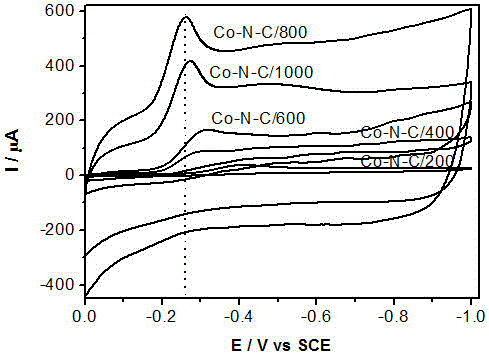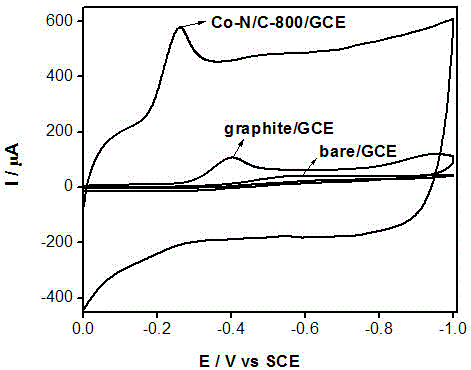Preparation method of non-noble metal oxygen reduction electrocatalyst for cathode of fuel cell
A fuel cell cathode and non-precious metal technology, which is applied in the direction of battery electrodes, chemical instruments and methods, physical/chemical process catalysts, etc., can solve the problem of high preparation cost, and achieve the effect of simple process, easy control, and wide application prospects
- Summary
- Abstract
- Description
- Claims
- Application Information
AI Technical Summary
Problems solved by technology
Method used
Image
Examples
Example Embodiment
[0030] Embodiment 1
[0031] (1) Take 1.5g of chitosan in a 250ml three-necked flask, add 90ml of ethanol aqueous solution (the volume ratio of ethanol to water is 5:4), heat and stir to swell the chitosan, and add 1.5ml of glacial acetic acid during the process to help Due to the rapid dissolution of chitosan, a viscous and transparent ethanol solution of chitosan is obtained, and the pH is between 4 and 5.5.
[0032] (2) The mixed solution of 3 ml of salicylaldehyde and 20 ml of absolute ethanol was slowly added dropwise to the transparent solution of (1) under constant stirring, heated to 79°C for reflux reaction for 10 hours, and filtered under reduced pressure to obtain a colloidal substance. Wash with absolute ethanol until the filtrate is colorless, and the filter cake is dried at 50°C to obtain the chitosan salicylaldehyde Schiff base compound.
[0033] (3) Measure 0.95 g of the chitosan salicylaldehyde Schiff base compound prepared in (2) into a three-necked flask, a...
Example Embodiment
[0037] Embodiment 2
[0038] (1) Weigh 0.90g chitosan (CS) into a 250ml three-neck flask, add 90ml ethanol aqueous solution (the volume ratio of ethanol to water is 5: 4), heat and stir to make chitosan swell, and add 1.5ml during the process Glacial acetic acid helps the rapid dissolution of chitosan to obtain a viscous and transparent chitosan ethanol solution with a pH of 4 to 5.5.
[0039] (2) Slowly add the mixed solution of 3 ml salicylaldehyde and 20 ml absolute ethanol dropwise into the transparent solution of (1) which is constantly stirred, heat to 79°C for reflux reaction for 10 hours, and filter under reduced pressure to obtain a gelatinous substance. Wash with absolute ethanol until the filtrate is colorless, and dry the filter cake at 50°C to obtain the chitosan salicylaldehyde Schiff base compound.
[0040] (3) Weigh 1.50g of the chitosan salicylaldehyde Schiff base ligand prepared in (2) into a three-necked flask, add 30ml of absolute ethanol, heat and stir to...
Example Embodiment
[0043] Embodiment 3
[0044] (1) Weigh 0.9g chitosan (CS) into a 250ml three-neck flask, add 90ml ethanol aqueous solution (the volume ratio of ethanol to water is 5: 4), heat and stir to make chitosan swell, and add 1.5ml during the process Glacial acetic acid helps the rapid dissolution of chitosan to obtain a viscous and transparent chitosan ethanol solution with a pH of 4 to 5.5.
[0045] (2) Mix 1.5 ml of salicylaldehyde and 20 ml of absolute ethanol in a dropping funnel, slowly add it dropwise to the solution of (1) under constant stirring, and heat and reflux at 79°C for 10 hours, then filter under reduced pressure , to obtain a gelatinous substance, which was washed with absolute ethanol until the filtrate was colorless, and the resulting filter cake was dried at 50°C to obtain a chitosan Schiff base ligand compound.
[0046] (3) Weigh 0.90g of the chitosan salicylaldehyde Schiff base ligand prepared in (2) into a three-necked flask, add 30ml of absolute ethanol, heat...
PUM
 Login to view more
Login to view more Abstract
Description
Claims
Application Information
 Login to view more
Login to view more - R&D Engineer
- R&D Manager
- IP Professional
- Industry Leading Data Capabilities
- Powerful AI technology
- Patent DNA Extraction
Browse by: Latest US Patents, China's latest patents, Technical Efficacy Thesaurus, Application Domain, Technology Topic.
© 2024 PatSnap. All rights reserved.Legal|Privacy policy|Modern Slavery Act Transparency Statement|Sitemap



